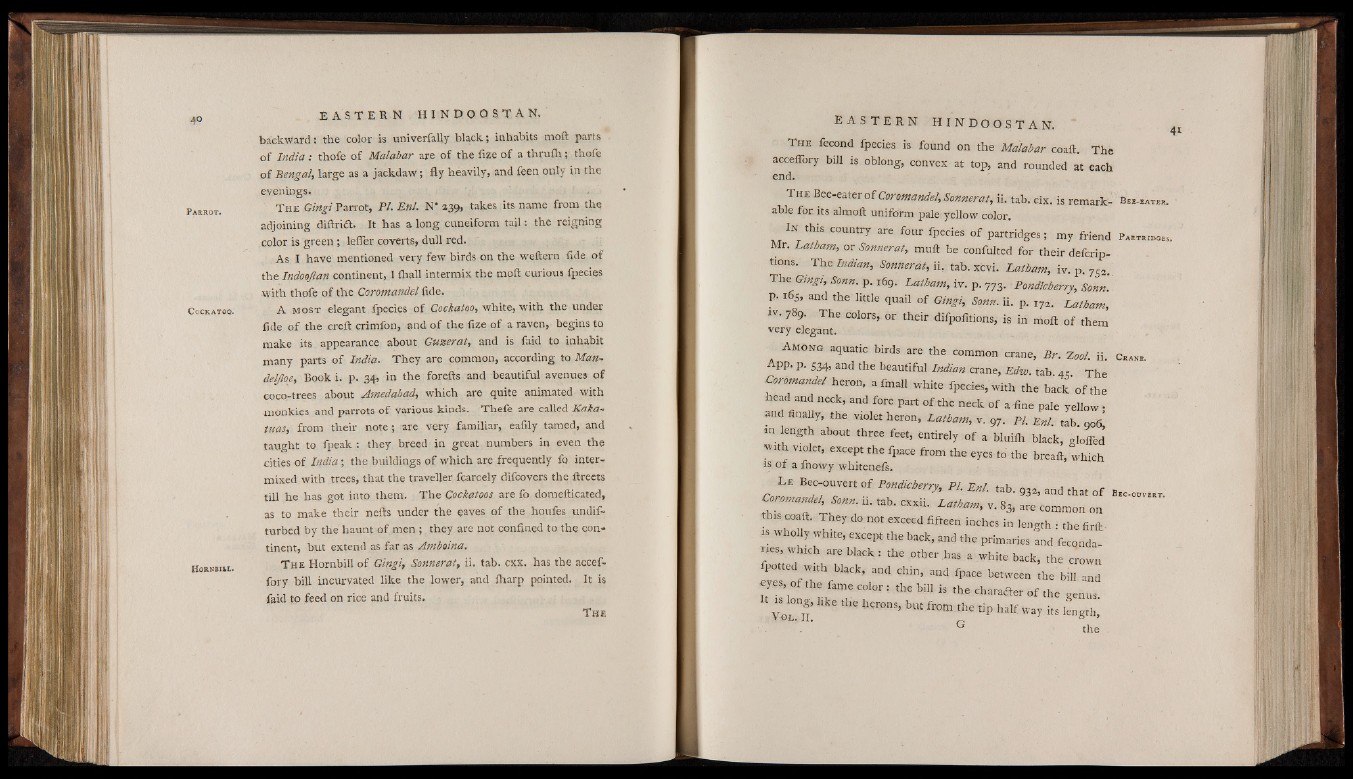
P ar ro t.
C ockatoq.
Horn bi il.
backward: the color is univerfally black; inhabits moft parts
of India : thofe of Malabar are of the fize of a thruih; thofe
o f Bengal, large as a jackdaw; fly heavily, and feen only in the
evenings.
T h e Gingi Parrot, P I . Enl. N* 239» takes its name from the
adjoining diftrict. It has a long cuneiform ta il: the reigning
color is green; lefler coverts, dull red.
As I have mentioned very few birds on the weftern fide of
the Indosjian continent, I ihall intermix the moft curious fpecies
with thofe of the Coromandel fide.
A m o s t elegant fpecies of Cockatoo, white, with the under
fide of the creft crimfon, and of the fize o f a raven, begins to
make its appearance about Guzerat, and is faid to inhabit
many parts of India. They are common, according to Man-
deljloe, Booki. p. 34, in the forefts and beautiful avenues of
coco-trees about Amedabad, which are quite animated with
monkies and parrots of various kinds. Thefe are called Kaka-
tuas, from their note; are very familiar, eafily tamed, and
taught to fpeak : they breed in great numbers in even the
cities of India ; the buildings of which are frequently fo intermixed
with trees, that the traveller fcarcely difcovers the ftreets
till he has got into them. The Cockatoos are fo domefticated,
as to make their nefts under the eaves of the houfes undif-
turbed by the haunt of men ; they are not confined to the continent,
but extend as far as Amboina.
T h e HombiH of Gingi, Sonnerat, ii. tab. cxx. has the accef-
fory bill incurvated like the lower, and iharp pointed. It is
faid to feed on rice and fruits.
T he
T h e fecond fpecies is found on the Malabar coaft. The
acceflory bill is oblong, convex at top, and rounded at each
end.
T h e Bee-eater of Coromandel, Sonnerat, ii. tab.cix. is remark- B ee- ea ter .
able for its almoft uniform pale yellow color.
In this country are four fpecies o f partridges; my friend P a ™ es.
Mr. Latham, or Sonnerat, muft be confulted for their defcrip-
tions. The Indian, Sonnerat, ii, tab. xcvi. Latbam, iv. p. 752.;
The Gtngt, Sonn. p. 169. Latham, iv. p. 773. Pondicherry, Sonn.
p. 165, and the little quail of Gingi, Sonn. ii. p. B Latham,
iv. 789. The colors, or their difpofitions, is in moft of them
very elegant.
A m o n g aquatic birds are the common crane, Br. Zool. ii. ■¿M
PP' p- 534> and the beautiful Indian crane, Edw. tab 4c The
Coromandel heron, a fmall white fpecies, with the back’ o f the
head and neck, and fore part o f the neck of afine pale yellow ■
and finally, the violet heron, Latham, v. 97. P i. Enl. tab. 00A
an length about three feet, entirely o f a bluifh black, gloffed
wit violet, except the fpace from the eyes to the breaft, which
as or a lnowy whitenefs.
c0^ l l 2 ° T n t t s * » PL EnL tab-Coromandel, Sonn. 11. tab. cxxii. Latham, v. 83, 9ar3e2 >caonmdm thoant o°nf T.
this coaft,- They do not exceed fifteen inches in length : the firft-
is wholly white, except the back, and the primaries and feconda-
ries, which are black: the other has a white back, the crown
fpotted with black, and chin, and fpace between the bill and
eyes, o f the fame color : the bill is the charafrer of the genus.
^ lo n g , hke the herons, but from the tip half way its fength,
G the